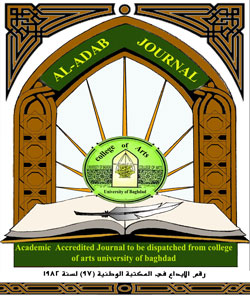The effect of soil Texture and apparent density on the growth and development of root systems of maize
DOI:
https://doi.org/10.31973/aj.v0i134.1018Keywords:
Soil Texture, Apparent density, Root systemsAbstract
The growing of plants in loam-sandy soils and loam soils is higher than in other soil types such as mud soils due to the very little space between the grains for air and water to circulate. The dry weight of roots and length of maize are higher in loam-mud soils and sandy soils than in mud soils. The decrease in length of maize results in the ability of maize to absorb water and nutrition. The research paper has come up with;
- The highest value of maize length has been recorded in soils with density of (28-60) because the space between the particles is relatively good.
- The lowest value of maize length has been recorded in soils with density of (80) because such soils are badly ventilated.
- The highest average value for maize leaves has been recorded in soils with density of (40).
- The lowest value of growing maize has been recorded in soils with density of (80) because the conditions of ventilation, absorptivity and space are bad.
- The highest value of vegetative growth has been recorded in soils with density of (0-17).
Downloads
References
AL-Niemi,S.N.1981.Soil misture regimes and soil type effected on growth and water relation of soybeans .Mesopotamia J.Agric .16;189-201.
Fehrenbacher,J,B,and R.H.Rust .1956 .Water budget approach to quantity corn grain yields under variable rooting depth . Soil Sci ;82;369-378.
Hassan Kutaibah Mohammed , The relationship of soil to water and plants , ministry of higher education and scientific research , university of baghdad , dar alhikmah for printing , 1990.
Hurd,E.A.1986.Growth of root of seven varieties of spring wheat at high and low moisture levels ,Agron .J.60; 201-205.
Ramadan hasson aziz , and athers , The effect of moisture and phosphorus on the growth of sorghum and zanko soybeans ,1985 p:137-143.
Weirsum , L.K,1957.The relationship of the size and structural rigidity of pores to their penetration by roots Plant and Soil . 9;75-85.
Downloads
Published
Issue
Section
License
Copyright and Licensing:
For all articles published in Al-Adab journal, copyright is retained by the authors. Articles are licensed under an open access Creative Commons CC BY 4.0 license, meaning that anyone may download and read the paper for free. In addition, the article may be reused and quoted provided that the original published version is cited. These conditions allow for maximum use and exposure of the work.
Reproducing Published Material from other Publishers: It is absolutely essential that authors obtain permission to reproduce any published material (figures, schemes, tables or any extract of a text) which does not fall into the public domain, or for which they do not hold the copyright. Permission should be requested by the authors from the copyrightholder (usually the Publisher, please refer to the imprint of the individual publications to identify the copyrightholder).
Permission is required for: Your own works published by other Publishers and for which you did not retain copyright.
Substantial extracts from anyones' works or a series of works.
Use of Tables, Graphs, Charts, Schemes and Artworks if they are unaltered or slightly modified.
Photographs for which you do not hold copyright.
Permission is not required for: Reconstruction of your own table with data already published elsewhere. Please notice that in this case you must cite the source of the data in the form of either "Data from..." or "Adapted from...".
Reasonably short quotes are considered fair use and therefore do not require permission.
Graphs, Charts, Schemes and Artworks that are completely redrawn by the authors and significantly changed beyond recognition do not require permission.
Obtaining Permission
In order to avoid unnecessary delays in the publication process, you should start obtaining permissions as early as possible. If in any doubt about the copyright, apply for permission. Al-Adab Journal cannot publish material from other publications without permission.
The copyright holder may give you instructions on the form of acknowledgement to be followed; otherwise follow the style: "Reproduced with permission from [author], [book/journal title]; published by [publisher], [year].' at the end of the caption of the Table, Figure or Scheme.











